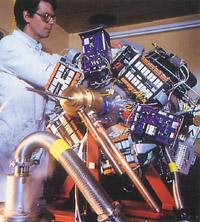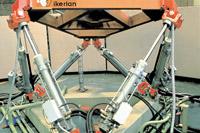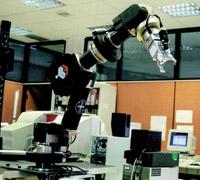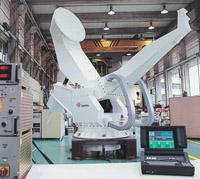Ikerlan in research

Past Past Past Past
According to Carlos Redondo himself, 25 years ago there was already something about research. The current director of Ikerlan, in 1974, along with 7-8 other people, left the Mondragón Polytechnic School and began working on the structure of Ikerlan. "For this to happen, several factors had to be merged. On the one hand, the role of then-Lankide Ahorros, who intended to create something related to research. On the other hand, around 30 cooperatives committed to subsidizing some such initiative met. Finally, the Polytechnic School provided human resources. The Caja Laboral Popular itself carried out infrastructures and buildings and Ikerlan was created." The Ikerlan technology centre was structured on three pillars, through the joint initiative of cooperatives, Caja Laboral and the Polytechnic School.

The current partner of Ikerlan is made up of 30 cooperatives at the time and 10 other companies, including some anonymous society. "Until 1982 we were a totally private team. Like all research centers, every year we had a deficit, since there were no public subsidies. All purchases of generic technology were assumed by companies, the rest we took out with projects we did for those companies. However, initially companies also came to fund 75% of our activity, 25% we achieved it through self-financing." All the beginnings are quite difficult, and Ikerlan knew how to face the situation little by little, since more and more projects were being carried out. In 1980 there was a significant first step. Ikerlan is a sectoral technology center created with the aim of working in the field of machine tool, appliances and electronics. The centre building itself is the reflection of this idea or intention, since in addition to the central building it has three others. "Then we realized that we could not make too much progress on that path, since technology does not distinguish areas or sectors. Therefore, we eliminate the importance of the areas and give importance to technologies, technologies and their specialization".
However, the most significant change occurred in 1982, after the signing of a collaboration agreement with the Basque Government. "The participation of the companies became almost symbolic, around 7%. The Basque Government took up to 50% on the basis of technological design projects." In the opinion of Carlos Redondo, at that time the Basque Government was very interested in consolidating the research structure that was being created, to complete the network of technological centers, which until then had nothing. On the one hand were Inasmet and Labein, especially experimental centers, on the other the CEIT of the School of Engineers of San Sebastian and Ikerlan, center of private initiative. The signing of the first collaboration agreement was the basis of the current network of technology centers, which joined the signing of the agreement. "This type of centers are normally deficient, as we cannot be continually transferring technology to the industry without this knowledge. The acquisition of the technology we called generic was the government's commitment to the agreement with the centers. Therefore, about half of our activity was paid by the Basque Government and the rest by projects with companies".

Although from the organizational point of view many things have changed from the beginning, from the point of view of technologies, the trajectory of the center of Arrasate has changed, but there is some fidelity. "We have not renounced the technologies we acquired or were willing to appropriate us in the creation of the center. We had electronics, mechanics, technical informatics and production, and I think that these four basic technologies, with other names and with the new knots and shapes that can arise from the evolution of technology, have not changed over time."
But the issues of fidelity are not limited to technologies in Ikerlan. Ideology also has its importance in this technological center. "From the beginning we are a cooperative. Most technology centers have evolved and have adopted a foundation structure, but I believe that being a cooperative is not an obstacle to the internal functioning system of the technology center."
From the outside, it may seem strange that while the rest are foundations, we remain cooperatives, but I think that the workers here do not want to give up the advantages of being a cooperative of services within a powerful cooperative group. We are willing to work with any company, but it would be difficult to change our features. If we made an internal referendum, I don't think anyone would like to change. This we have done among all, our heritage is here, we participate in the decisions… it is important. The rest of the centers have become foundations, but I think that's because the associative structure they had did not benefit them and because money allows it to be a non-profit entity."
Present Present

At this time Ikerlan is structured in three areas: electronics, design and production technologies and energy. The electronics area is divided into four areas: automatic and control engineering, sensors and artificial vision, electronics and communications, advanced software and artificial intelligence. The meeting point of all these departments is the workshop of electronic prototypes, where the prototypes resulting from the projects are made. In the field of design and production technologies there are also several areas: CAD-CAM department, production systems department, mechanical engineering department, technical office or prototype workshop. The third field of research is that of energy, without department, but that is studying topics such as air conditioning and comfort, combustion, renewable energies, the good use of energy, new systems of power generation, etc.
This would be the current structure of Ikerlan. Structure yes, but why? "We only do projects. And if necessary, what sets us apart, what places us in better position with respect to others, are product development projects. 70% of the research under contract with companies focuses on product development or improvement of the existing product.
We always work on demand, and there we have done everything: The development of all the home automation products that Fagor is launching on the market, the control systems and electronics of elevators, the electronics systems in beverage machines, the Bilbao metro in the field of transport, the airport signaling systems and everything that can not be said in the industrial field.
I have talked about differentiation and precisely when speaking today about competitiveness, we have to talk about cost reduction and differential aspects. The reduction of costs is increasingly difficult, since the market is globalized and is not feasible. Therefore, we have to be competitive, but through specialization, and in our case in product innovation."
According to the director of Ikerlan, the Arrasate technology centre works on demand. However, there is a big difference between having to go in search of commissions or having the orders arrive by themselves. In that sense, Ikerlan is not in bad position. "We are still in the demand market, we get more of what we could offer. That means that we still have to choose. The truth is that, although we grow constantly, we are totally satisfied. In Ikerlan we now have a team of 150 people and I think we are on the border, but in the next strategic plan we have to delve into the issue of growth. This same year we had to deny some projects because we did not have enough people to respond correctly to the jobs." The status of a cooperative, and also being a cooperative of the MCC group, may have to do with the abundant situation in Ikerlan. "A third of our projects are financed by public institutions, mainly by the Basque Government, another third belongs to MCC companies and the last third corresponds to other companies. That is, two thirds of contracts and a third of public entities".

According to the words of Carlos Redondo, Ikerlan is very well located among the technological centers of the Basque Country. "Periodically we maintain collaboration agreements with the rest of the technology centers, as well as with Mondragon Unibertsitatea in research, in this case continuously. We also have relationships with other international research centers, according to the projects, we have worked with MIT (Massachusetts Institute of Technology), we are working with the University of Glasgow, with the University of Berkeley in California…". Ikerlan has also taken international steps, but not as in the local market. "Normally we are not going to Europe to seek funding. Sometimes we leave because some company asks for help in a specific project; sometimes strategically, to be able to access a new technology, it can be interesting for us. The possibilities of working in Europe are enormous, but if we look at it, we can forget the reality here. Therefore, as far as Europe is concerned, we are quite selective and have the limit set: European projects can make up a maximum of 10% of our activity. We are here and our job is to make technology transfer here. The agreements of collaboration with the rest of the world are specific according to the projects".
Future of the future
Ikerlan's present seems healthy and, although the future cannot be predicted, it seems that the future, in view of where and in what circumstances part, can be prosperous. In view of the future of research in the Basque Country, Carlos Redondo is optimistic because, in addition to the association of technological centers, it is where the Basque network of technology is located, among other things. "Now a powerful research network is being structured. One of the main objectives of the 2001-2004 Research Plan is the consolidation of the Basque technology network, which is important. Currently, in terms of research and development, we are 1.3% of the gross domestic product, compared to 0.3% of 1982-83. Progress has been enormous, although we are farther than Europe. But we are approaching. Also, keep in mind that all of us who are in this, including companies, are very clear that without driving research and development we have nothing to do."
The future cannot be predicted because it is not easy to know whether things can change or not. However, Ikerlan is working on the strategy for the coming years. And they have more than one challenge. "As we are seeing in the development of the Strategic Plan for the next four years, we must modify the structure of Ikerlan. So far we have been organized in different areas, but I think we are going to bet on product development. A product development unit that encompasses all areas of electronics, mechanics, and prototypes may be created. We would also structure a new unit more related to design, production and business management. And the third unit would be energy.
Our constant challenge is to see how technology evolves, analyze what new technologies are created and select them based on it. At this moment we want to bet on optoelectronics and microsystems, since microscopic technologies or nanotechnologies are gaining great strength in all developed countries. Then in the field of energies, we are betting on new sources of energy, for fuel batteries of small power". Therefore, if the commitment to small size technologies is adequate, the future can be large.
Significant dates and significant dates
Years 1975-77. At birth, the first microprocessor in the Basque Country was presented in Ikerlan and two years later the first industrial robot. "Then we had an obsession to master the technology and those who collected the most technology were robots, so we started working with robotics. The robots assembled mechanical engineering, prototype design, electronics, sensors, control, power electronics, etc. We perform a robot, not for its commercial exploitation, but for the acquisition of new technologies and its subsequent use in the industry. It was important because then we started to create different departments of the center."
Year 1982. Signature of the collaboration agreement with the Basque Government.
Year 1984. On behalf of the Basque Government, Ikerlan carried out a plan to disseminate CAD-CAM and microelectronics technologies. Courses were conducted in companies, on the one hand, to influence the importance of microelectronic technologies in the development of products and facilitate access to them, and on the other, to teach to implement CAD-CAM systems in companies. "It was a great informative work and the work itself strengthened the center in these areas."
Year 1985. Ikerlan participated for the first time in a European project. "I think we were the first technology centers here to participate in an international project. It was a project on flexible manufacturing systems, and in Ikerlan we used a large infrastructure, since we installed the first flexible manufacturing cell to be built in the state."
Year 1994. Ikerlan sent a project to space. "Due to its characteristics the space technology is not difficult, but it is possible that the procedures, the way to perform the work, the requirements, the quality regulations and the incorporation to the projects. We did it through the European Space Agency, but we have also obtained contracts from companies to launch the project. We did not want to give too much importance to this line, although it is good to have open doors in space technology."
Year 1994. It was decided to abandon the scope of industrial robotics, which served to capture technology but not to transfer it. This was important for Ikerlan because of the repercussions that robots had at that time. "The industrial robots that we have built are no longer manufactured. In fact, it was impossible to face the competitiveness of foreign companies. However, we knew that robotics to address new technologies is very interesting, so we delve into mobile robotics and space robotics. There we developed the first mobile robots, with the same initial philosophy, mechanical systems, mobile systems, sensors, artificial vision systems…. Because we had to dominate. We knew beforehand that we would have few industrial applications, and most of the mobile robotics works we have carried out have been developed in projects, but with a small industrial application."
Year 1998. Inauguration of the energy center in Miñano, Parque Tecnológico de Álava.





